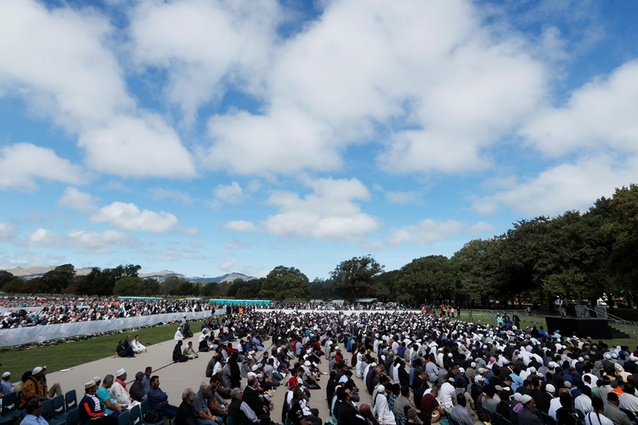Editorial: Taking it outside
Chris Barton, editor of Architecture New Zealand, explores how taking the fight against terrorism outside can reclaim both public and sacred space.
So much hidden, underground, camouflaged, background has become shocking foreground and painfully visible since the horrific events of 15 March in Christchurch: figure-ground starkly reversed. Now in the light is terrorism’s unacknowledged face: the insanity of white supremacism laid bare.
Also exposed is the country’s latent racism and Islamophobia – hundreds raised concerns with the Human Rights Commission before the mass murders about anti-Islam behaviour, especially against Muslim women. We see, too, for the first time in New Zealand history, the terrorism threat level raised to “high”. Seeing the Muslim call to prayer in public, 20,000 in attendance at Hagley Park and televised live was both moving and inspirational.
Also highly visible is the form – the dome and minaret – of the Al Noor Mosque, now a regular news image and portrayed by a crowd in Pakistan dressed in white, another group spelling the words “Islam is peace”. The hijab worn by non-Muslim became a signifier of compassion and solidarity.
Throughout all of the above, which I think of as the changing space of Christchurch, “the threat” – unspecified and difficult to predict – has been manifest. By now, many New Zealanders have experienced its ongoing effects – cancelled gatherings. The cancellations seem random: two concerts in Christchurch on 17 March cancelled along with Polyfest in Auckland. WOMAD, in New Plymouth, went ahead with armed police around the festival perimeter, inside the event and outside the artists’ hotels and yet two-thirds of Auckland’s Anzac Day services were canned. Armed police were everywhere.
This public display of police around the country carrying guns – Glock 17 pistols in their holsters and Bushmaster M4 semi-automatic rifles slung over their shoulders – while the National Threat Level remained at high is confusing. What’s it for? To protect us, make us feel safe? Or does it make us more afraid? And what’s the threat – more terrorism, copycat, retaliation?
Vice-Chancellor Stuart McCutcheon decided to cancel the University of Auckland’s autumn graduation processions. Despite acknowledging “no specific risk” to the processions or ceremonies, the Vice-Chancellor was concerned there might be “vehicle as a weapon” incidents that have been seen in other cities. There were neither resources nor time available to block off all intersections and side streets between Old Government House and the Aotea Centre to prevent such a thing, plus traffic disruption to the city in doing so would be highly problematic. Unitec and the University of Canterbury made similar decisions.
I can’t help thinking such cancellations are understandable but fundamentally flawed. The WOMAD decision and the public event in Hagley Park show a much better response – one that both takes a stand against terrorism and racism and says we will not be bowed. One that says our right to gather in public space will not be taken from us.
This was in stark contrast to what I observed when I accompanied a group of MArch students on a parliamentary tour on a Saturday at the beginning of April. Police with their semi-automatics were outside. We filed through a scanner and were relieved of our mobiles. Distressingly, under the Speaker’s orders, we were not permitted to see the debating chamber. The key space of our democracy and what we stand for denied. Isn’t this just the sort of disruption and fear that terrorists hope for?
You can understand the police guarding mosques and other Islamic places, such as schools, because, undoubtedly, many in our Muslim community felt unsafe, afraid to go outside after the mass murders. But, for some I spoke to, used to being regularly racially profiled and intimidated by authorities, especially at airports, the reversal – the police now guarding them – felt an odd mix of reassuring and ironic. As it might have been to find crowds from their surrounding communities, previously rarely seen around Muslim places, now gathering as a show of support – not just at the Al Noor Mosque and the Linwood Islamic Centre in Christchurch but at other locations, such as Auckland’s Ponsonby mosque. To me, with a complicated racial and religious heritage of Muslim (my Turkish maternal grandfather), Jewish (my mother) and pākehā Christian (my father), all of which could, historically and currently, make a person a target, such actions are more powerful and reassuring than armed police.
The recent attacks on churches in Sri Lanka and a synagogue in San Diego show how sacred spaces are terrorists’ frequently preferred places of attack. While terrorists’ aims may be to create division among people because of the way they pray, it’s also clear that, when blood is spilt in these sacred places, paradoxically, they become more sacred – sites of the slaughter of innocents. The terrorists know this but extremist ideology seeks to engage in the insanity and chaos of endless war because, without that, these small extremist groups would wither and die.
To combat the extremist creed, the public call to gather at Hagley Park with an estimated 20,000 people is, undoubtedly, a way forward. Yes, security was tight and buses were used to block off all nearby roads, with cordons guarded by armed police and officers circulating through the crowd. The real protection came from the solidarity, compassion and strength in numbers.
Taking the call to prayer public and outside also carries a powerful message of resistance, one where the architecture of the mosque, or synagogue or church – the sacred space of belonging and the terrorist target – becomes invisible, but also more visible than ever before.
This article first appeared in Architecture New Zealand magazine.











